Do you have a question about the Samsung C49RG9 Series and is the answer not in the manual?
Ensure adequate space around the monitor for ventilation to prevent overheating and damage.
Avoid using ultrasonic wave humidifiers nearby to prevent white stains on glossy models.
Follow instructions to prevent serious or fatal injury and property damage.
Steps for safely cleaning the monitor screen and exterior using a soft, dry cloth.
Guidelines for safe use of power cords and sockets to prevent electric shock.
Instructions and warnings for safely installing the product, avoiding heat sources and unstable surfaces.
Warnings and precautions for safe operation, including avoiding disassembly and handling hazards.
Details parts, control panel, function key guide, and game setting keys.
Guides on adjusting brightness, contrast, sharpness, volume, and eye saver mode.
Explains port types, software upgrades via USB, and anti-theft lock.
Instructions for attaching and removing the stand, and wall mounting.
Essential checks before connecting any source device to the monitor.
Details on connecting a PC via HDMI and DP cables for optimal use.
Guides for connecting headphones, microphones, and audio cables.
Using the monitor as a USB hub to connect multiple devices to a PC.
Instructions on connecting USB devices like mice, keyboards, and storage directly to the monitor.
Steps to connect the monitor to a power outlet and the product.
Methods for organizing and securing cables for a neat setup.
Guidelines for maintaining correct posture while using the monitor for comfort and health.
Instructions for installing drivers and setting the optimum display resolution.
Optimizing picture modes, refresh rate, and screen size for gaming.
Adjusting Black Equalizer, Response Time, FreeSync, and Low Input Lag for better gaming.
Using Virtual Aim Point and saving custom game settings.
Selecting picture modes, adjusting brightness, contrast, sharpness, and color.
Configuring HDMI Black Level, Eye Saver Mode, Screen Adjustment, and Calibration.
Setting the menu language and adjusting the OSD display time.
Performing self-diagnosis and viewing system information.
Adjusting lighting, local dimming, volume, ECO saving, and timers.
Configuring PC/AV mode, USB charging, DisplayPort, HDMI, source detection, and key repeat.
Managing power LED status and resetting all system settings.
Details on installing and using the Easy Setting Box software for partitioning.
System requirements and potential problems during software installation.
Steps before contacting support and basic product testing.
Resolving display problems, color inconsistencies, no sound, and choppy video.
Frequently asked questions for common issues like changing frequency and power saving.
Details on model name, size, pixel pitch, power, and connectors.
Lists supported resolutions, frequencies, and sync polarities for HDMI and DisplayPort.
Explains charges for service calls based on defect type and customer fault.
Instructions for the correct disposal of the product as electronic waste (WEEE).
Ensure adequate space around the monitor for ventilation to prevent overheating and damage.
Avoid using ultrasonic wave humidifiers nearby to prevent white stains on glossy models.
Follow instructions to prevent serious or fatal injury and property damage.
Steps for safely cleaning the monitor screen and exterior using a soft, dry cloth.
Guidelines for safe use of power cords and sockets to prevent electric shock.
Instructions and warnings for safely installing the product, avoiding heat sources and unstable surfaces.
Warnings and precautions for safe operation, including avoiding disassembly and handling hazards.
Details parts, control panel, function key guide, and game setting keys.
Guides on adjusting brightness, contrast, sharpness, volume, and eye saver mode.
Explains port types, software upgrades via USB, and anti-theft lock.
Instructions for attaching and removing the stand, and wall mounting.
Essential checks before connecting any source device to the monitor.
Details on connecting a PC via HDMI and DP cables for optimal use.
Guides for connecting headphones, microphones, and audio cables.
Using the monitor as a USB hub to connect multiple devices to a PC.
Instructions on connecting USB devices like mice, keyboards, and storage directly to the monitor.
Steps to connect the monitor to a power outlet and the product.
Methods for organizing and securing cables for a neat setup.
Guidelines for maintaining correct posture while using the monitor for comfort and health.
Instructions for installing drivers and setting the optimum display resolution.
Optimizing picture modes, refresh rate, and screen size for gaming.
Adjusting Black Equalizer, Response Time, FreeSync, and Low Input Lag for better gaming.
Using Virtual Aim Point and saving custom game settings.
Selecting picture modes, adjusting brightness, contrast, sharpness, and color.
Configuring HDMI Black Level, Eye Saver Mode, Screen Adjustment, and Calibration.
Setting the menu language and adjusting the OSD display time.
Performing self-diagnosis and viewing system information.
Adjusting lighting, local dimming, volume, ECO saving, and timers.
Configuring PC/AV mode, USB charging, DisplayPort, HDMI, source detection, and key repeat.
Managing power LED status and resetting all system settings.
Details on installing and using the Easy Setting Box software for partitioning.
System requirements and potential problems during software installation.
Steps before contacting support and basic product testing.
Resolving display problems, color inconsistencies, no sound, and choppy video.
Frequently asked questions for common issues like changing frequency and power saving.
Details on model name, size, pixel pitch, power, and connectors.
Lists supported resolutions, frequencies, and sync polarities for HDMI and DisplayPort.
Explains charges for service calls based on defect type and customer fault.
Instructions for the correct disposal of the product as electronic waste (WEEE).
| Screen Size | 49 inches |
|---|---|
| Resolution | 5120 x 1440 |
| Panel Type | VA |
| Refresh Rate | 120 Hz |
| Aspect Ratio | 32:9 |
| Brightness | 600 cd/m² |
| Response Time | 4ms (GTG) |
| Curvature | 1800R |
| HDR | HDR1000 |
| Contrast Ratio | 3000:1 |
| AMD FreeSync | Yes |
| Viewing Angle | 178° (H) / 178° (V) |
| VESA Mount | Yes (100 x 100 mm) |
| Connectivity | DisplayPort 1.4, HDMI 2.0, USB Hub |
| Color Support | 125% sRGB |
| Weight | 14.6 kg |
| Ports | Headphone |
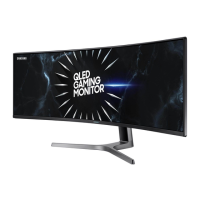
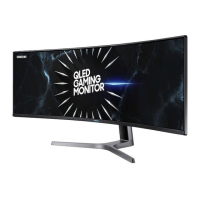
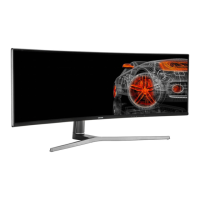

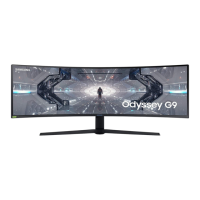
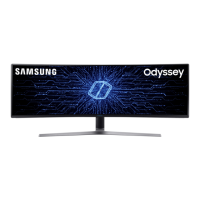
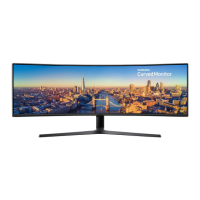
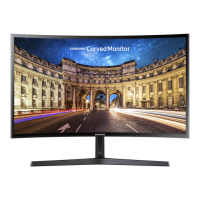
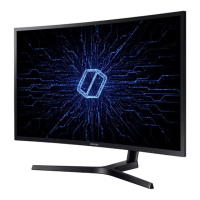
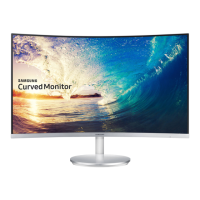


